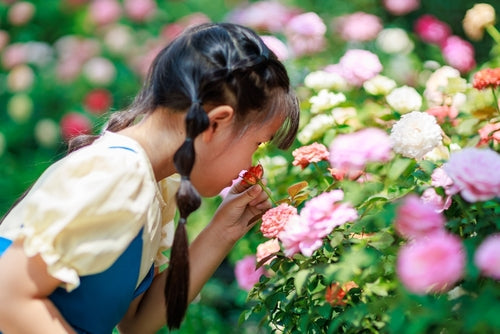
Sensory garden ideas for your home
Sensory gardens are designed to simulate all five senses; sound, sight, smell, touch and taste. This is a great way to ground yourself in nature, spend some time away from the hustle and bustle of the outside world, and engage with your senses.
Having a space designed by you can bring a sense of achievement, and plants can uplift your mood and promote health. Adding a rich blend of plants, flowers, textures, fruit, and veg is a perfect concoction for a sensory garden.
This idea is autism-friendly and is a great way to get your kids involved with nature and gardening.
The benefits of a sensory garden
Aside from improved mental and physical health, sensory gardens can improve our fine and gross motor skills, balance and coordination. This is perfect for children, as getting them involved in gardening will help them develop more efficiently.
Connecting with nature allows us to develop a deeper understanding and connection to the earth. Gardens can improve the ecosystem, allowing wildlife to thrive and feed on plants and homegrown food sources.
Sensory gardens are perfect for adults and children with autism and dementia, providing a safe space to explore and engage with their surroundings. Spending time in nature can be therapeutic and calming, helping regulate our nervous system.
1. Colourful flowers
Aesthetically pleasing gardens are great to walk around and take in the sights. Humans are drawn to beautiful things, and that applies to nature too. Adorning your garden with a range of colourful flowers will satisfy your senses.
Here are a few ideas to get you started:
- Roses
- Sunflowers
- Tulips
- Zinnia
- Clematis
2. Fragrant flowers and herbs
Fragrant flowers and herbs are perfect for satisfying both sight and smell. The fragrance of floral is calming and can lower anxiety and stress levels. Adding them to your garden will help you to immerse yourself in the natural world and ground yourself.
Herbs are a perfect addition to your flower patch. Alongside providing rich smells, herbs can be used for medicinal and cooking purposes, allowing you to create your own herbal remedies and collect ingredients to upgrade your meals.
Here are some fragranced flower and herbal recommendations:
- Gardenia
- Freesia
- Peony
- Lavender
- Basil
- Mint
- Rosemary
3. Bird feeders
Having a bird feeder in your garden is great for attracting wildlife. Bird watching can be a calming and satisfying experience for many, and adding an area for bird food to your garden will surely attract many visitors.
You can hang bird feeders up high on a tree trunk or add them to your fence so you can watch the birds come in and out of your garden.
4. Water features
The sound of running water is very relaxing and grounding.
Adding a pond to your garden will attract lots of wildlife, and you can add your own fish to create a habitat in your backyard. Children will love watching the fish swim about, and you can get them involved in building the pond and feeding the fish.
Placing a water fountain in your garden is a good centrepiece to add character and beauty to the space. You could opt for a minimalist design if you want to keep it simple, or you could purchase a unique fountain that features sculptures of fairies, frogs, or engraved carvings.
5. Wind chimes and garden spinners
This is a great idea if you have young children in your household. The children will love the bright colours and musical sounds that the chimes generate, encouraging them to spend more time outside.
Wind chimes can also be calming to adult ears. You could set up a meditation or journaling space in this area of your garden to help with relaxation and grounding activities.
6. Ornaments and sculptures
These features are very common in many gardens. Having creative or attractive designs in your garden uplifts the beauty of the space and provides more sights for you to indulge in.
Adding pots, stone sculptures, fairy features and gnomes, animal ornaments, and pebbles will help create a beautiful garden space that engages all the senses.
7. Gravel paths and wooden walkways
Adding a path to your garden will give it some dimension and organisation. Walkways are perfect for creating spiral effects that lead to each garden feature. Using gravel will add auditory elements to your garden, with the satisfying crunch of each step.
This is a perfect idea for families with disabilities or sensory difficulties. Adding one key auditory element will provide a less overwhelming environment to explore, as there is little auditory input.
8. Seating areas
A good seating area is essential for a garden. Having a place to sit provides a great setting for social gatherings and a place to sit alone and reflect, appreciating your new garden setup.
You could add a bench, garden chairs and table, or a patio area for a more comfortable and relaxing option. You could even create a secret lounge area in your garden shed.
9. Plants with various textures
Textured plants can add contract and tactile elements to a garden space.
These are perfect for aiding children’s development and exploration of nature and for children with additional needs. Here is a list of some plants with unique textures:
- Lambs ear
- Moss
- Begonia rex
- Globe thistle
- Bunny tails grass
- Rattlesnake plant
10. A vegetable patch
This is a great option to incorporate more fruit and vegetables into your family's diet. Planting fruit and veg seeds can be more affordable than buying supplies from your local store.
This way, you can enjoy the activity of growing, tending, picking and cooking your own food and involve your children in the process.